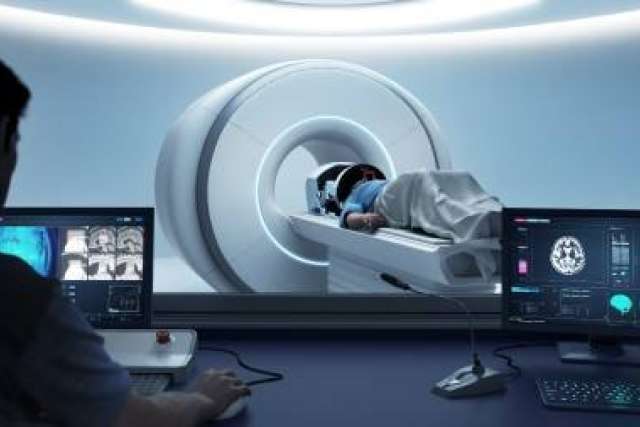Photo top: Dr. Ausaf Bari is director of the functional and restorative neurosurgery program at UCLA.
Loss of motor control due to essential tremor or Parkinson’s disease can drastically affect quality of life. Medication can help, but may eventually stop working or lead to intolerable side effects.
While deep brain stimulation has been used for several decades as a surgical therapy for movement disorders, a new, incision-less option called MRI-guided focused ultrasound (MRgFUS) provides an alternative therapy.
This treatment, approved by the U.S. Food and Drug Administration, can alleviate symptoms in patients whose tremor is not responsive to medications. UCLA is one of only three academic medical centers on the West Coast approved for this procedure.
The UCLA MRgFUS program is a collaborative effort between the departments of Neurology and Neurosurgery.
“The science behind the procedure is the innovative use of high-energy ultrasound,” explains UCLA neurologist Krishe Menezes, MD. “It works the same way as a magnifying glass that can focus the sun’s rays to burn a small, precise hole in a piece of paper.”
MRI-guided focused ultrasound requires no incisions in the scalp, no holes to be made in the skull, and no implanted device, so the risk of infection is low and no follow-up adjustments are needed. The treatment is an outpatient procedure, and the benefits take effect immediately.
However, unlike deep brain stimulation, the therapy is only approved for use on one side.
With MRI for guidance, the procedure is performed by functional neurosurgeon Ausaf Bari MD, PhD, director of the functional and restorative neurosurgery program at UCLA. Using highly advanced technology, hundreds of tiny ultrasound beams are focused on an area in the brain the size of a pea associated with tremor. A lesion of this area, also known as the VIM nucleus of the thalamus, acts to eliminate the abnormal tremor-producing signals emanating from this region.

The patient is awake and responsive during the procedure, and can communicate with the surgeon to allow the surgeon to adjust the beams precisely, increasing the safety and efficacy of the therapy.
“That’s a major advantage of this technique,” says Dr. Bari. “We have direct feedback from the MRI and from the patient.”
Dr. Bari begins by aiming the beam at a lower intensity and interacts with the patient to test whether there are any potential side effects, such as numbness. If these side effects are seen, the lower temperature allows him to adjust the beam without permanent side effects.
Once Dr. Bari identifies the optimal target, with the patient’s tremor significantly reduced and minimal side effects, he then increases the intensity to create a permanent effect.
“MRI-guided focused ultrasound thalamotomy is a good option in patients who have tremor that does not respond to medications, do not want incisions or holes made in their skull, and are OK with treatment of one side only,” Dr. Menezes says. “Results for this procedure are immediate, and the patient can go home the same day.”
The UCLA team has extensive experience with MRgFUS, performing the procedure about four to six times per month.
Patients who come to UCLA for treatment first meet with a team of neurologists and neurosurgeons in a joint appointment to determine whether the procedure is right for them. Because the therapy is an outpatient procedure and there is no hardware to program or adjust, after the treatment is performed the patient’s primary physician can take over follow-up care when the patient returns home.
It takes two to three hours to perform the procedure, which involves a full head shave and placement of a temporary frame applied to the head. The stereotactic frame minimizes head movement and increases accuracy.
During the therapy, Dr. Bari regularly interacts with the patients and talks them through all steps of the procedure in order to make them as comfortable as possible.

Some patients are able to reduce their tremor medications or even stop them completely after undergoing the procedure. Focused ultrasound opens up a new option for patients who may otherwise not be candidates for surgery.
“The majority of people who undergo focused ultrasound treatment would not have been candidates for deep brain stimulation,” says Dr. Bari.
The procedure was approved by the FDA for essential tremor in 2016 and for tremor due to Parkinson’s disease in 2019. Dr. Bari has been performing focused ultrasound thalamotomy since 2014, having trained at the University of Toronto on a prestigious Van Wagenen Fellowship while the procedure was being developed there.
“UCLA has a long history and extensive experience in treating tremor,” says Dr. Menezes. “We are happy to announce this new tool in our armamentarium to treat this debilitating condition.”
Learn more abpout MR Guided Focused Ultrasound at UCLA Health.
Caroline Seydel is the author of this article.





